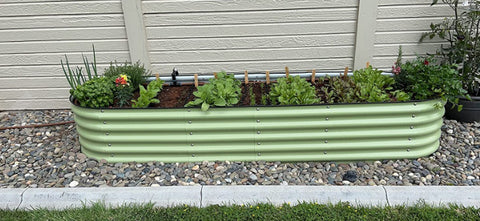How To Create An Efficient Raised Bed Garden
Raised Garden Bed Garden is a unique garden design that allows your plants to grow at high altitudes and avoids contact with weeds and insects on the ground. They can also help save space and improve soil drainage and aeration. In this article, I will introduce how to create an efficient raised garden bed garden.
Select Material
Raised garden beds Gardens are usually framed using wood or metal. Wood is the most commonly used choice because it is cheap, easy to process, and easy to maintain. Common wood types include pine, fir, mahogany, and oak. If you choose to use metals, you need to choose materials that are rust and corrosion resistant, such as aluminum, iron, or galvanized steel.
Define dimensions
The size of the raised garden bed garden can be adjusted according to your needs. Typically, they have a height of 1-3 feet, a width of 2-4 feet, and a length of 4-12 feet. You can define dimensions based on your space and plant needs.
Prepare the site
Before preparing the site, you need to determine whether it is necessary to lay a grass proof film at the bottom to avoid the invasion of weeds. If you choose to use a grass proof film, you need to lay a layer of grass proof cloth on the ground, and then place the raised garden bed garden on top. If you do not use a grass proof film, you need to clean up the grass and debris on the site.
Assemble raised garden bed garden
Depending on the material you choose, you need to assemble the frame of the raised garden bed garden according to the instructions. If you choose to use wood, you will need to drill holes, install screws, and nails. If you choose to use metal, you need to use bolts and nuts to splice the frame together.
Adding soil
Adding soil is the final step in creating a raised garden bed garden. You need to select high-quality soil to fill the raised garden bed garden. Generally speaking, raised garden beds require adding a layer of organic matter, such as compost or rotting soil, to help maintain the moisture and fertility of the soil. Then you can add the mixed soil until it fills the raised garden bed garden.
Planting plants
Planting plants is the final step in creating a raised garden bed garden. You need to choose plants that are suitable for growing in a raised garden bed garden. Generally speaking, plants suitable for raised garden beds include plants with shallow roots that require less water, such as vegetables, herbs, perennials, and herbs. You can add fertilizer or organic matter to the soil before planting to improve the nutrition and growth of the plant.
Manage Raised Garden Bed Gardens
Raised garden beds Gardens require regular maintenance to ensure the health and growth of plants. You need to water regularly to keep the soil moist, but do not over water it. You also need to remove weeds and dead leaves and fertilize them regularly. If your raised garden bed garden is exposed to sunlight, you may need to add shading nets or other obstructions to keep the plants healthy.
Overall, a raised garden bed garden is a very useful garden design that can help save space, improve soil drainage and ventilation, avoid the invasion of weeds and insects, and provide a more manageable plant growth environment. Creating an efficient raised garden bed garden requires selecting the right materials and sizes, preparing the site, assembling the raised garden bed garden, adding soil and planting plants, and then maintaining and managing it regularly.

